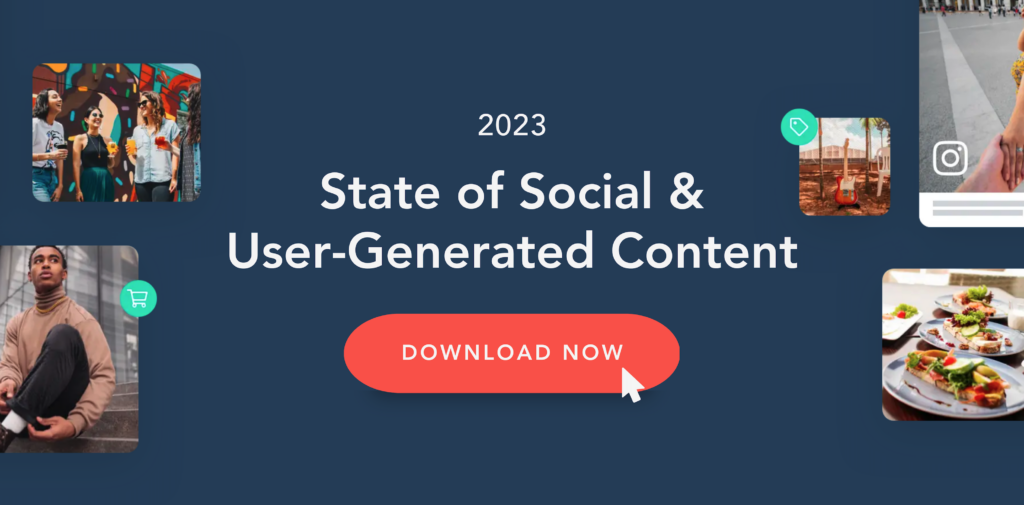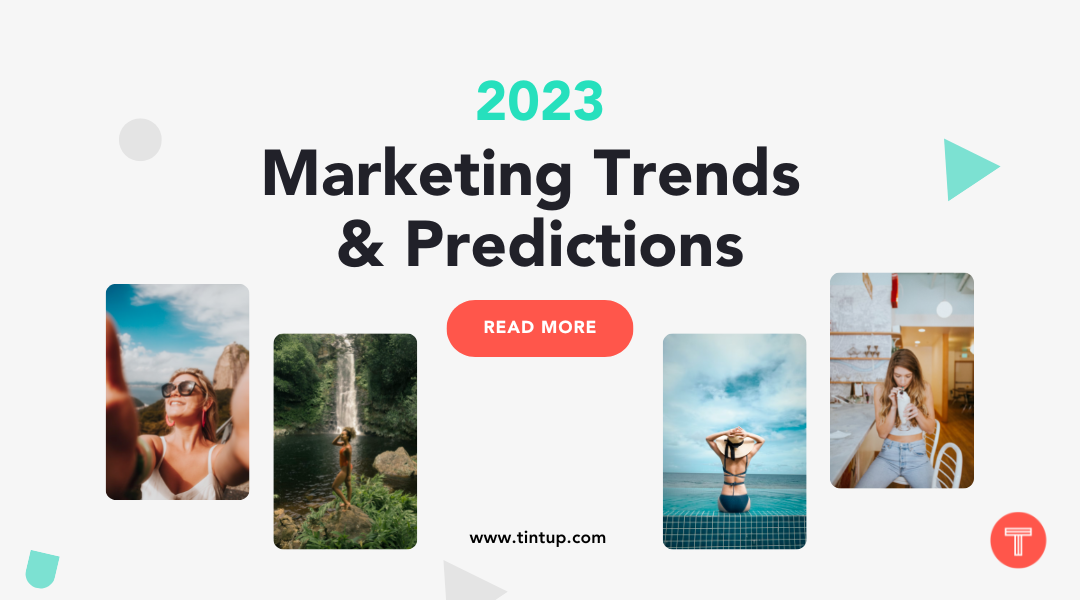There’s a lot happening in the world of marketing in 2023. Gear up for this year’s marketing trends and predictions!
As technology continues to evolve and consumer behavior shifts, marketers will need to stay on their toes to keep up with the latest trends and developments.
Here are a few predictions we can expect to see in the world of marketing in 2023 – based on our annual State of User-Generated Content Report.
In 2020, we predicted the rise of UGC. Today, just one scroll through social media shows how accurate that prediction was.
In 2021, we followed up our UGC prediction with a rise in UGC creation and the new roles that would support it. Cue the newest (outsourced) role in content marketing – UGC Creators.
In 2022, we saw that slashed marketing budgets and UGC were coming together to create small yet powerful marketing teams.
In 2023, we’re predicting less static content and more video and audio content, social media as a search engine, and a priority on analyzing content ROI.
(Get free access to our 2023 State of User-Generated Content Report for more statistics and insights into these 7 marketing themes)
Here’s why.
Marketing Trends and Predictions for 2023
Theme #1: More Investments Across Video and Audio
Brands are shifting their social media strategies to keep pace with changing consumer behavior and the increasing demand for engaging content.
Facebook, Instagram, and LinkedIn are currently the top three platforms that brands are focusing on, but they are planning to ramp up activity on Instagram, TikTok, and YouTube to better reach consumers who are expected to spend more time on those platforms. Gen Z is particularly active on TikTok, which may explain why brands are focusing on that platform.
In 2023, 78.51% of marketers plan to invest in video, but only 19.52% feel like they have the necessary resources and teams to create high-quality visual content. This aligns with the platforms that they are planning to increase activity on.
Consumers also seem to recognize the value of video and audio in branding, with 66.41% believing that brands that use these formats stand out more than those that don’t.
Theme #2: Social Media As A Search Engine
Social media is quickly becoming a go-to source for consumers looking to discover new products, brands, and experiences.
In fact, 75.78% of consumers have used social media to search for or discover these things, with Facebook, Instagram, and YouTube being the most popular platforms for such searches.
Additionally, 68.75% of consumers have made a purchase based on something they saw on social media, highlighting its importance as a discovery and purchasing tool. It’s worth noting that Facebook may be popular among older demographics, which could explain its inclusion in the top three platforms.
Theme #3: Consumers Want More Ratings And Reviews
Ratings and reviews play a crucial role in helping consumers make informed decisions and ultimately convert into buyers.
79.69% of consumers check ratings and reviews before making a purchase, and 75% are aware when they are being advertised to.
Marketers recognize the importance of ratings and reviews in driving conversions, with 69.08% stating that they are crucial to their strategies. However, only 35.75% of marketers regularly incorporate user-generated content (UGC) into their campaigns. As Brayden Cohen, Social Media and Employee Advocacy for Hootsuite explains, “UGC helped us build awareness and credibility for our organization. People trust a company stakeholder, like an employee, way more than they trust a brand.”
By leveraging ratings and reviews, marketers can help consumers feel more confident in their purchasing decisions and ultimately drive conversions.
Theme #4: Stock Photography Is Out (UGC Is In)
People trust authentic, unpaid recommendations from real customers more than any other type of content.
Brands should focus on showcasing real customers and their experiences with the brand, rather than relying on generic stock photography that is commonly seen across the internet.
In terms of trustworthiness, authentic user-generated content (UGC) is the most trusted, followed by content from creators, brand content, influencers, and staged UGC.
However, marketers still seem to believe that brand content is more trustworthy than UGC, which creates a slight misalignment with consumer preferences. 80.47% of consumers prefer seeing photos of real customers over stock photography, yet 59.87% of marketers still rely on stock video and photography for visual content.
In fact, 57.03% of consumers feel that stock photography should be replaced with diverse images of real customers and teams. This is an area where marketers could improve, as only 23.03% of them always request rights to other people’s content. This leaves a significant portion of marketers at risk of legal issues and brand faux pas.
Theme #5: Too Much Content, So Little Time
Limited resources can make it difficult for marketers to deliver high-quality experiences at a fast pace.
Over 35.53% of budgets remained unchanged, while 35.96% actually decreased. As a result, 60.97% of marketers feel that they don’t have enough resources to produce the amount of content that they need. As Youri Hollier, Director of Digital and Social at Tim Horton’s explains, “so often, there may be one social media manager [or marketer] that’s responsible for content creation, ideation, community management, and reporting in what should be a 40-hour workweek. That’s just too few people for such an important function of a business.”
This isn’t just a volume issue, but it is still a significant challenge. In order to share content at a high frequency with limited budgets and time, marketers need to be strategic and prioritize their efforts.
This might mean focusing on creating high-quality content that can be repurposed or shared across multiple channels, rather than trying to produce a large volume of mediocre content.
Theme #6: Influencers vs. Creators: Which Should You Use?
As the creator economy continues to grow, the terms “influencers” and “creators” have become increasingly interchangeable.
However, there is a clear difference between the two, and marketers and consumers alike recognize this. 53.73% of marketers agree that influencer content converts at a higher rate than brand content, which suggests that trust may not necessarily be correlated with conversions. 72.59% of marketers also agree that there is a distinction between influencers and creators, and 65.6% of consumers believe the same.
It’s important for marketers to understand the differences between these two groups in order to leverage them effectively in their campaigns.
Theme #7: ROI is Expected (But Not Always Straightforward)
Marketing teams could benefit from more effectively measuring the performance of their content across channels.
While 54.17% of marketers believe that their team has the methodology to predict which visual content will convert, only 18.2% always measure the performance of their content. This means that there is room for improvement in this area. The reasons for this may vary, but common barriers might include a lack of resources, time, or knowledge.
By investing in performance measurement and tracking, marketers can gain valuable insights into the effectiveness of their content and make more informed decisions about their strategies.
Stay Ahead of Marketing Trends & Predictions
2023 is shaping up to be an exciting year for marketers, with a range of new trends and developments emerging.
As the creator economy continues to grow, marketers will need to focus on leveraging authentic user-generated content and working with influencers and creators to reach consumers. Video and audio will also play an increasingly important role in branding, and marketers will need to invest in these formats in order to stand out. However, limited resources may be a barrier for some, and marketers will need to be strategic in order to create high-quality content at a fast pace.
By staying on top of evolving marketing trends and predictions – and adapting their strategies accordingly – brands can position their brands for success in the coming year.
See what’s unfolding for marketers inside our 2023 State of User-Generated Content Report.





